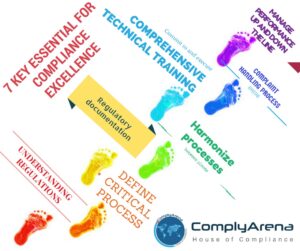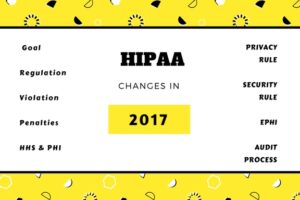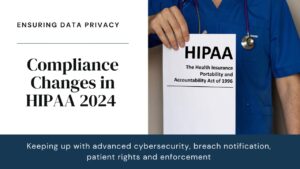Introduction
- HIPAA has evolved to keep pace with advancements in technology and healthcare practices.
- 2024 introduces significant compliance updates to enhance the protection of health information.
- This article outlines key changes and their implications for healthcare providers, business associates, and patients.
Enhanced Cybersecurity Requirements
- New Standards for Encryption:Advanced Algorithms, required for data at rest and in transit to ensure sensitive health information remains secure.
- Multi-Factor Authentication (MFA)Mandatory MFA, adds a layer of security through multiple forms of identification, such as passwords, security tokens, and biometric verification.
- Mitigating Cyber RisksPrevent Unauthorized Access measures aim to mitigate risks of unauthorized access and cyberattacks.
- Updated Security Policies:Compliance – Healthcare organizations must update their encryption methods and access control policies to comply with the new standards.
Expanded Scope of Covered Entities
Inclusion of Digital Health Platforms
- Expanded Definition:Now includes telemedicine providers, mobile health apps, and online health services.
- Comprehensive Privacy Measures:Digital health platforms must implement robust privacy and security protocols to safeguard patient health information (PHI).
Business Associates Liability
- Stronger Compliance Requirements:Includes regular risk assessments, security controls, and breach reporting.
- Accountability:Covered entities must ensure business associates comply with updated requirements.
Enhanced Breach Notification Requirements
Shortened Breach Notification Timeline
- 30-Day Notification Requirement:For affected individuals and HHS.
- Updated Breach Response Plans:Organizations must quickly identify, assess, and report breaches.
Detailed Breach Reports
- Comprehensive Information:Must include the nature of the breach, types of information involved, potential impact, and mitigation steps.
- Enhanced Transparency:Requires robust documentation and reporting processes.
Strengthened Patient Rights
Right to Access Electronic Health Records
- Easy and Prompt Access:Patients can access their health information in electronic format.
- Secure Online Portals:Providers must offer secure means for patients to view and download their information.
Right to Request Amendments
- Request Corrections or Updates:Patients can request amendments to their health records.
- Timely Responses:Providers must respond within a specified timeframe and document changes.
Compliance and Enforcement
Increased Penalties for Non-Compliance
- Substantial Fines:For organizations failing to meet new requirements.
- Regular Audits and Assessments:Ensure ongoing compliance.
Enhanced Enforcement Activities
- Frequent and Comprehensive Audits:Conducted by the OCR.
- Corrective Action Plans and Monetary Penalties:For non-compliant organizations.
Conclusion
- Proactive Updates:Healthcare providers, business associates, and digital health platforms must update policies, procedures, and systems.
- Prioritizing HIPAA Compliance:Enhances patient trust, reduces data breach risks, and ensures the confidentiality and integrity of health information.





